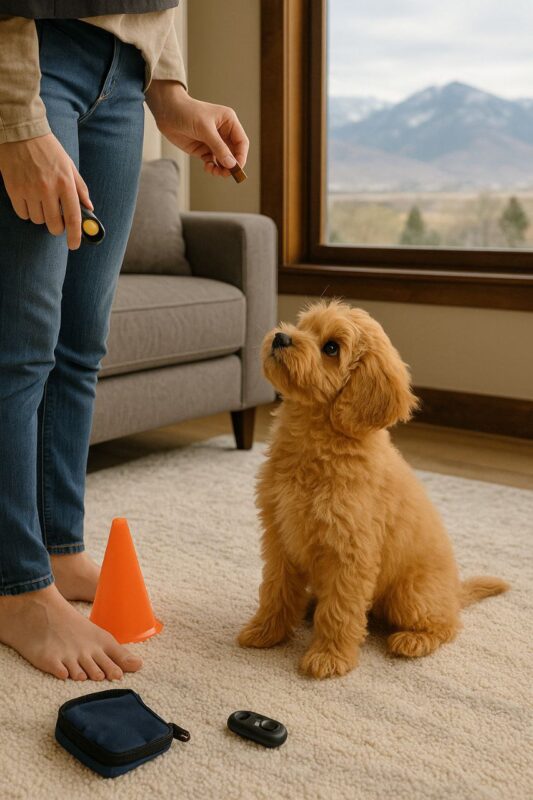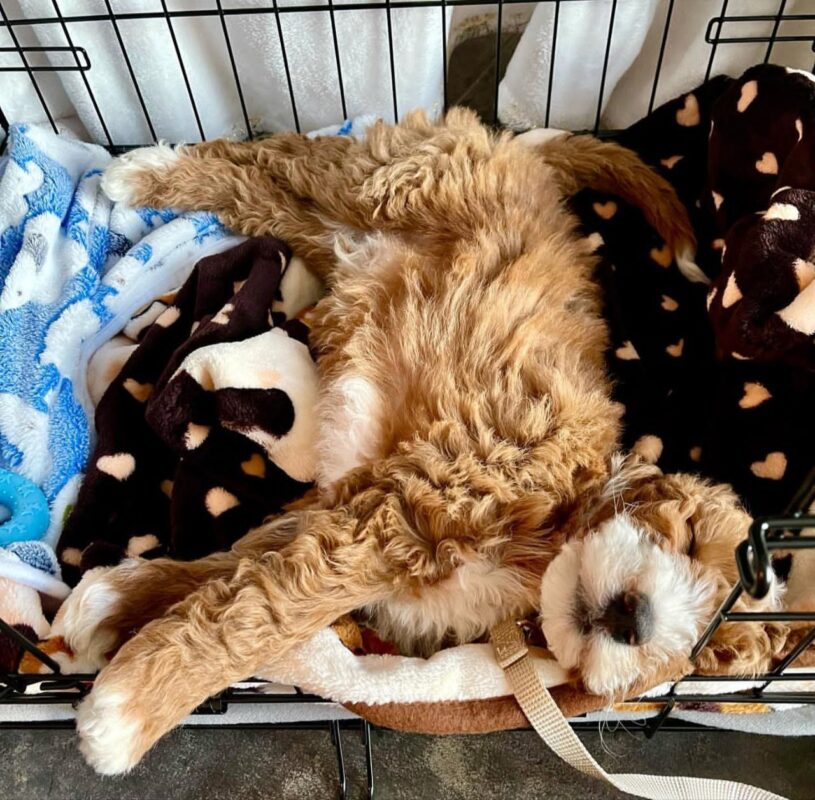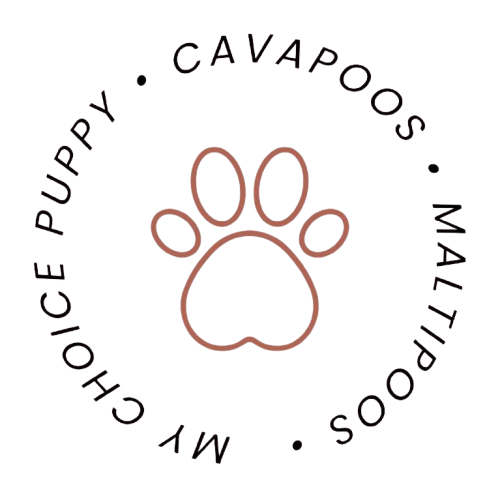CAVAPOO BLOG
Cavapoo Training 101: Tips and Tricks for a Well-Behaved Pup
7 Smart Cavapoo Training Tips for a Well-Behaved Pup
Cavapoos, the charming crossbreed of a Cavalier King Charles Spaniel and a Poodle, are cherished for their affectionate personalities, intelligence, and adorable teddy bear-like looks. These qualities make them highly trainable, but raising a well-behaved Cavapoo requires patience, consistency, and the right approach. Training helps your Cavapoo become a polite, confident companion who thrives in any family setting. This comprehensive guide explores everything you need to know about training your Cavapoo, from teaching basic commands to fostering socialization and addressing common behavioral challenges. Whether you’re a first-time dog owner or an experienced pet parent, this 2,200-word guide offers practical tips and tricks to ensure your Cavapoo grows into a well-mannered, joyful pu
Table of Contents
ToggleWhy Cavapoo Training Matters
Cavapoos combine the Poodle’s sharp intelligence with the Cavalier’s gentle nature, making training both rewarding and necessary. Without proper guidance, their smarts can lead to mischief, such as chewing shoes or barking at visitors, while their sensitivity calls for gentle, positive methods. Training establishes clear boundaries, strengthens your bond, and helps your Cavapoo adapt to various environments, from busy households to quiet homes. Starting early, ideally around 8 weeks, sets the stage for a confident, well-behaved Cavapoo. A consistent approach prevents unwanted behaviors, ensuring your pup becomes a cherished family member with good manners.
Setting Up for Successful Training

Before beginning, create an environment that supports learning and keeps your Cavapoo focused. Here’s how to prepare:
Choose a Quiet Space: Select a calm area, like a living room corner or a fenced backyard, to minimize distractions during training sessions.
Gather Supplies: Stock up on small, tasty treats, a leash, a collar or harness, and toys for rewards. A clicker can help mark desired behaviors.
Establish a Routine: Plan short, 5-10 minute sessions 2-3 times daily to keep your Cavapoo engaged without causing fatigue.
Focus on Positive Reinforcement: Cavapoos respond best to rewards like treats, praise, or play, as harsh corrections can upset their sensitive temperament.
A thoughtful setup makes training productive and enjoyable, helping your Cavapoo learn quickly and grow into a well-behaved companion.
Teaching Basic Commands
Mastering basic commands is a key part of training, laying the foundation for a well-behaved Cavapoo training session. Focus on these essentials to build strong obedience skills:
Sit: Hold a treat above your Cavapoo’s nose, moving it back until their bottom touches the ground. Say “sit” and reward with a treat and praise. Practice daily to reinforce.
Stay: Ask your Cavapoo to sit, then hold your hand out, say “stay,” and step back. Reward for staying in place, gradually increasing distance and time.
Come: In a safe, enclosed area, say “come” in an excited tone and gently pull the leash, rewarding with treats when they reach you.
Down: With your Cavapoo sitting, move a treat toward the ground to encourage lying down. Say “down” and reward promptly.
Keep sessions short, upbeat, and consistent. Using positive reinforcement ensures your Cavapoo masters these commands, setting the stage for further obedience training.
Socializing Your Cavapoo for Confidence
Socialization is crucial for raising a confident, well-behaved Cavapoo. Between 8-16 weeks, when they’re most receptive, introduce your Cavapoo to different people, pets, sounds, and environments in a controlled way. Arrange playdates with friendly dogs, visit pet-friendly stores, or take short car rides to build familiarity. Reward calm behavior with treats and praise to create positive associations. Effective socialization prevents fearfulness or aggression, ensuring your Cavapoo is comfortable in diverse settings, from crowded parks to quiet homes. Puppy training for Cavapoos should prioritize these experiences to foster adaptability and good manners.
Pro Tip: Consider a puppy socialization class for structured exposure under professional guidance, enhancing your Cavapoo’s social skills.
House Training Your Cavapoo

House training is a vital step in ensuring your Cavapoo becomes a well-mannered companion indoors. Follow these steps for success:
Set a Schedule: Take your Cavapoo out every 2-3 hours, after meals, naps, playtime, or waking up, to a consistent potty spot.
Use a Cue Word: Say “go potty” while they eliminate, rewarding with treats and praise immediately after to reinforce the behavior.
Supervise Indoors: Watch for signs like sniffing or circling, and redirect to the potty spot to prevent accidents.
Handle Accidents Calmly: Clean accidents with an enzymatic cleaner to remove odors, avoiding punishment to maintain trust.
With consistent effort, most Cavapoos master house training within 3-6 months, creating a clean and stress-free home environment.
Crate Training for Comfort and Routine
Crate training is a helpful tool, providing a safe space and aiding house training efforts. Choose a crate large enough for your Cavapoo to stand, turn, and lie down comfortably, and make it cozy with a soft bed, blanket, and toys. Introduce the crate gradually to ensure a positive experience:
Step 1: Place treats inside to encourage exploration, leaving the door open to build comfort.
Step 2: Feed meals in the crate to create positive associations with the space.
Step 3: Close the door briefly while they’re inside, gradually increasing time to build tolerance.
Step 4: Use the crate for naps, short periods when you’re home, or overnight, ensuring it’s a welcoming retreat.
Avoid using the crate as punishment. A well-crate-trained Cavapoo feels secure and adapts to routines, contributing to good behavior.
Addressing Common Behavioral Challenges
Cavapoos are generally well-mannered, but some behaviors may require targeted training to ensure they remain polite:
Excessive Barking: Cavapoos may bark at strangers, noises, or excitement. Teach the “quiet” command by rewarding silence after a bark and addressing triggers, such as limiting exposure to passing cars by closing curtains.
Chewing: Provide a variety of chew toys and redirect chewing to appropriate items. Supervise closely, especially during puppy training, to prevent destructive habits.
Separation Anxiety: Cavapoos’ attachment to owners can lead to anxiety when left alone. Practice short absences, reward calm behavior, and provide engaging toys like puzzle feeders.
Jumping Up: Ignore jumping and reward when all four paws are on the ground to teach polite greetings, reinforcing good manners.
Addressing these issues early through Cavapoo behavior training ensures your pup remains well-adjusted in various situations, from family gatherings to public outings.
Advanced Cavapoo Training and Mental Stimulation

Once basic commands are mastered, advanced training keeps your Cavapoo engaged and mentally sharp. Teach tricks like “roll over,” “spin,” “shake,” or “fetch” to challenge their intelligence, inherited from their Poodle parent. Use puzzle toys, scent games, or treat-dispensing toys to provide mental stimulation, as Cavapoos thrive on problem-solving. Enroll in agility or advanced obedience classes to develop skills, confidence, and coordination. Mental stimulation prevents boredom, reducing unwanted behaviors like chewing or barking and ensuring your pup remains a well-behaved Cavapoo.
Pro Tip: Rotate toys weekly and incorporate Cavapoo training into playtime for a fun, learning-focused experience that keeps your Cavapoo engaged.
Incorporating Exercise into Training
Exercise is a critical component of Cavapoo training, channeling energy and promoting good behavior. Cavapoos have moderate energy levels, requiring 1-2 daily walks (30-60 minutes total) and playtime like fetch, tug-of-war, or short romps in a secure yard. Integrate Cavapoo obedience training into exercise by practicing commands like “sit,” “stay,” or “come” during walks or play sessions. For example, ask your Cavapoo to “sit” before throwing a ball or “come” during a park outing. Regular activity keeps your Cavapoo calm, focused, and receptive to training, supporting their journey to becoming a well-behaved Cavapoo who thrives in any environment.
Working With Professional Trainers
For challenging behaviors or faster progress, professional Cavapoo training can be a valuable investment. Seek trainers experienced with small breeds or Poodle mixes who use positive reinforcement methods, as Cavapoos respond poorly to harsh techniques. Group classes offer socialization benefits, exposing your Cavapoo to other dogs and people, while one-on-one sessions target specific issues like separation anxiety, leash pulling, or excessive barking. Professional Cavapoo obedience training accelerates progress, ensuring your pup becomes a well-behaved Cavapoo who fits seamlessly into your home and lifestyle.
Tips for Long-Term Training Success
Maintaining a well-behaved Cavapoo requires ongoing commitment to Cavapoo training. Here are strategies for long-term success:
Stay Consistent: Use the same cues, rewards, and rules across all family members to avoid confusing your Cavapoo.
Refresh Skills Regularly: Practice commands and tricks weekly to prevent regression, even after mastery, reinforcing Cavapoo obedience training.
Adapt to Life Stages: Adjust training as your Cavapoo grows, addressing challenges like adolescent rebellion or aging-related changes in behavior.
Involve the Family: Encourage everyone to participate in Cavapoo training to ensure consistent reinforcement and strengthen the bond with your pup.
Monitor Progress: Keep a training journal to track milestones and identify areas needing extra focus, such as specific behaviors or commands.
Long-term dedication to Cavapoo training ensures lasting obedience, a strong bond, and a well-behaved Cavapoo who brings joy for their 10-15-year lifespan.
Frequently Asked Questions About Cavapoo Training
1. At what age should I start Cavapoo training?
Begin puppy training for Cavapoos at 8 weeks, focusing on socialization and basic commands to build a foundation for a well-behaved Cavapoo.
2. How long does it take to house train a Cavapoo?
With consistent Cavapoo training, house training typically takes 3-6 months, depending on your pup’s age and routine.
3. Are Cavapoos easy to train?
Cavapoos are highly trainable due to their intelligence and eagerness to please, making Cavapoo training rewarding for owners.
4. How can I stop my Cavapoo from barking excessively?
Cavapoo behavior training can curb excessive barking by teaching the “quiet” command and addressing triggers like noises or strangers.
5. Is crate training necessary for Cavapoos?
Crate training isn’t mandatory but aids house training and provides a safe space, supporting a well-behaved Cavapoo.
6. What’s the best way to socialize a Cavapoo?
Expose your Cavapoo to people, pets, and environments between 8-16 weeks, rewarding calm behavior during puppy training for Cavapoos.
7. How do I handle separation anxiety in my Cavapoo?
Practice short absences, provide engaging toys, and reward calm behavior to ease anxiety through Cavapoo behavior training.
8. Can Cavapoos learn advanced tricks?
Their intelligence makes them great candidates for tricks like “roll over” or agility, enhancing Cavapoo training outcomes.
9. How much exercise supports Cavapoo training?
Cavapoos need 1-2 daily walks (30-60 minutes) and playtime to stay focused, supporting Cavapoo obedience training success.
10. Should I hire a professional trainer for my Cavapoo?
Professional Cavapoo training can help with specific issues or accelerate progress, especially for first-time owners.
Conclusion
Cavapoo training is a fulfilling journey that transforms your pup into a well-behaved Cavapoo who brings joy to your home. By using positive reinforcement, establishing consistent routines, and addressing behaviors early, you can ensure your Cavapoo thrives in any environment. From mastering basic commands to socialization, advanced tricks, and ongoing care, these tips and tricks pave the way for a polite, confident companion. Start your Cavapoo training journey today, stay patient, and enjoy building a lifelong bond with your furry friend.
Call-to-Action: Ready to train your Cavapoo puppy? Begin with short sessions, grab some treats, or consult a professional trainer for personalized advice. Share your Cavapoo training success stories or questions in the comments below!


Pingback: 7 Essential Cavapoo Health Dog Breeds and Care
Pingback: 5 Key Cavapoo Socialization Tips for 2025 Success
Pingback: History & Origins of the Cavapoo Breed in 2025: A Fun Guide
Pingback: Maltipoo Breed Guide 2025: History, Health, & Fun Facts
Pingback: Can Cavapoos be Left Alone? 10 Amazing Tips to Avoid Anxiety
Pingback: Do Cavapoos Have a Smell? 10 Essential Healthy Tips